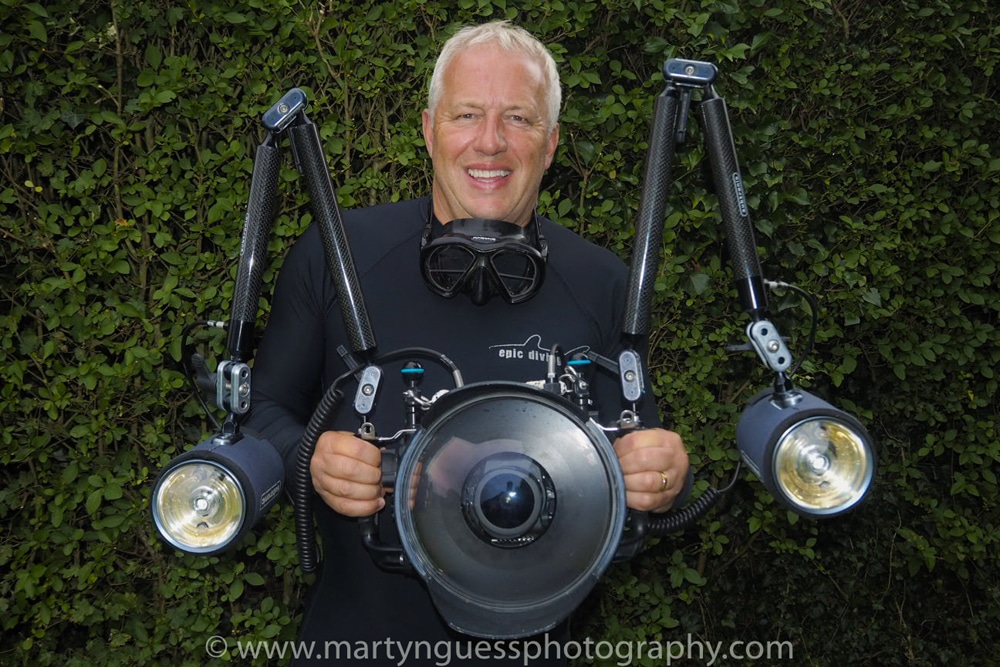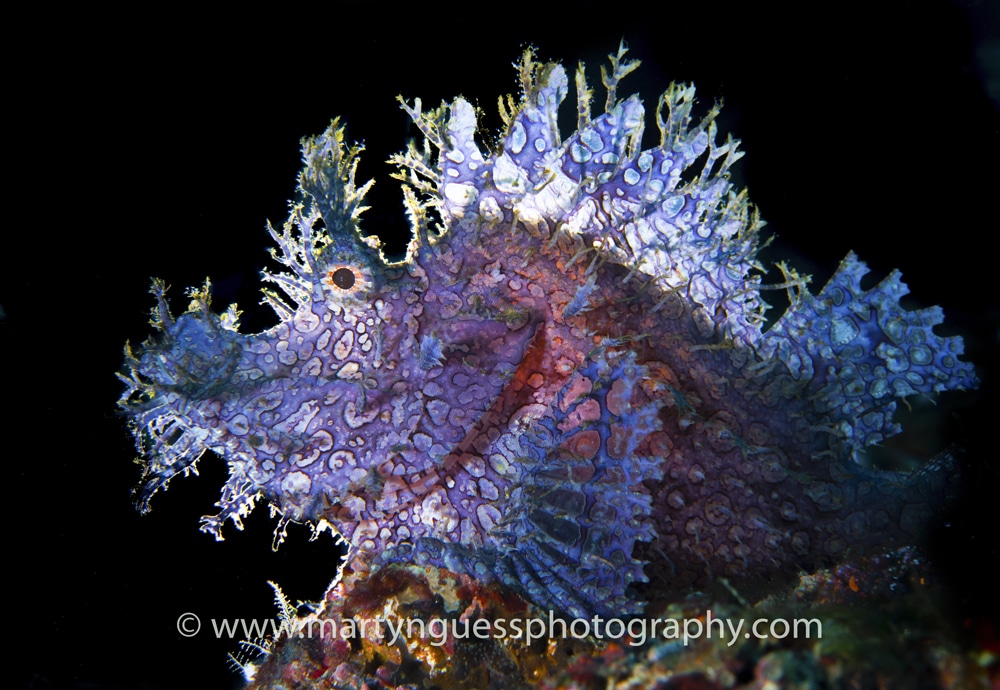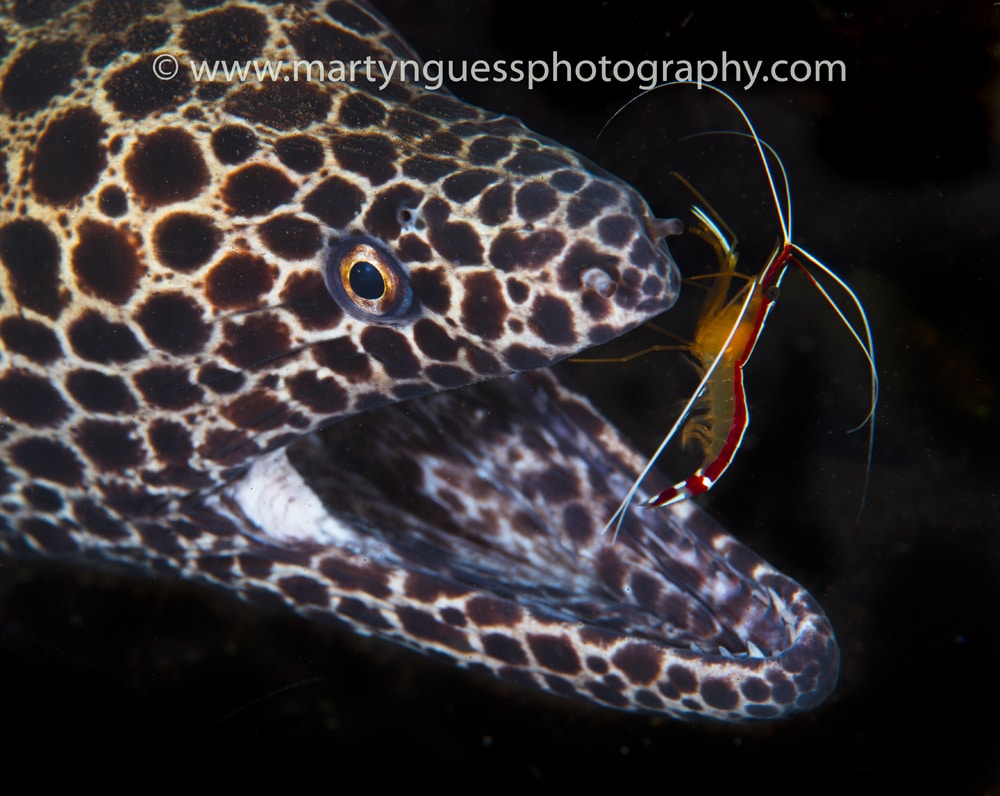Photo / Video News & Reviews
Scubaverse Underwater Photographer Interview: Martyn Guess
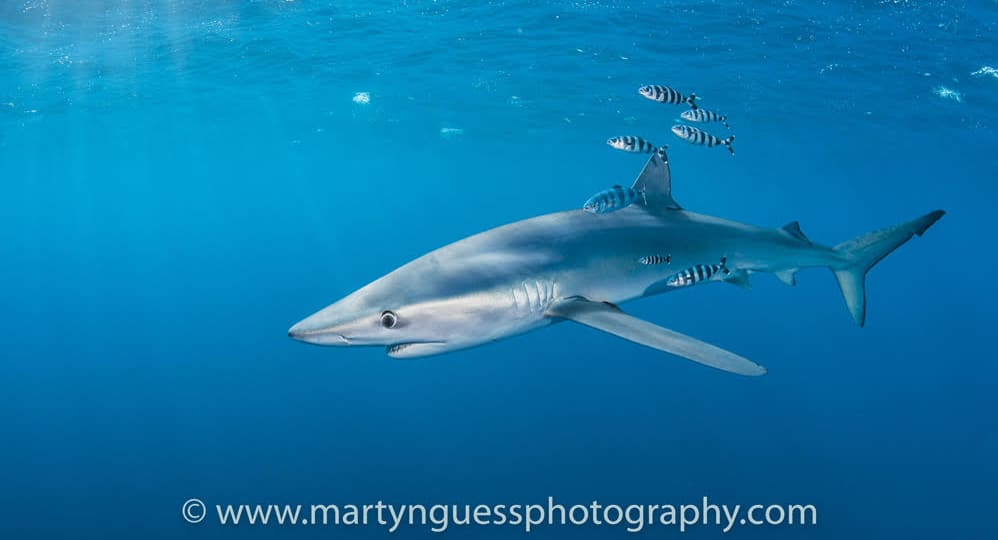
In an ongoing series, Scubaverse’s Underwater Photography Editors Nick and Caroline Robertson-Brown talk to underwater photographers from around the world that they admire. In this blog: Martyn Guess…
My diving career started in the late 1970’s when a family friend took me underwater in southern Spain. An interesting experience given that he managed to knock my mask off with his fins on the first dive! I was amazed by the colours and fish life and very keen to pursue the sport, although it wasn’t until quite a few years later that I went through the formal training process, together with my eldest son, and we both qualified on his 12th Birthday at Stoney Cove in the UK.
Since then, and over the last 22 years, I have dived all over the world and visited some amazing places and seen some wonderful things.
I have travelled extensively through Indonesia and the Philippines and have managed to build up an extensive portfolio of weird and wonderful creatures which I primarily post on Instagram.
I have had a fair amount of success with national and international competitions and I am now passing on some of my knowledge as I teach underwater photography, primarily by running photographic workshops with Scuba Travel, but I also do some one to one courses in the UK. We are going to the Azores in September with a group following a research trip there last summer and also Anilao, Philippines in May and Bali in October. I am keen to take photographers to the best places and some new destinations. I have recently become Chairman of Photosub – the Surrey based group of underwater photographers started by the late Len Deely; we have some very talented people in the club.
N&C: How did your underwater photography start?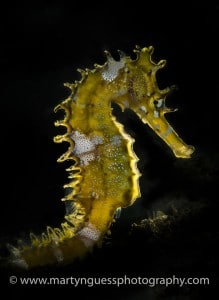
MG: A couple of years after I qualified in 1995 I went on holiday to Grand Cayman and found myself diving with Cathy Church, who with her husband Jim wrote the definitive book on the Nikonas V film camera for underwater use. I had been a keen land photographer since college days and was fascinated by some of the images in her shop, so it only took a day or two before I signed up for a course with her. I have to say I was immediately smitten and on the slippery slope!
When I got back home I went to see Alan James in Bristol and bought the same camera. For those that don’t know the Nikonas it was a great little camera but focus was achieved by guesswork and setting the F stop to an open aperture giving you infinity, or little prongs that stuck out from the lens for macro and close up use when a smaller aperture was selected. The idea being to get the subject between the prongs – no mean feat! You were also limited to 36 exposures with no real idea of how the images would look until the film had been processed. However, despite all of this I was hooked and used the Nikonas for quite a few years until digital cameras started to come onto the market.
N&C: What is your favourite u/w camera equipment (past & present) & why?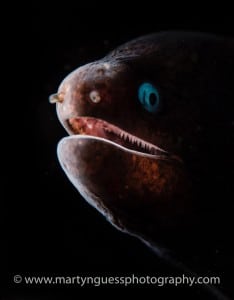
MG: I currently use a Nikon D5 which is a truly amazing camera. One of my favourite tools to use with the camera is the Retra LED Snoot which only allows a small amount of light from the strobe to hit the subject. You can isolate subjects from the background and where the subject is on a mucky bottom or distracting background this can be really useful in creating images that leap off the page. They are easier to use than people think and I teach the techniques on my workshops. It is always rewarding to see people reap the benefits of this type of lighting.
The Retra is so much better and easier to use than the old snoots that I had to make from plumbing parts, as the strobe modelling light shines through the snoot and is magnified so that it can be easily aimed. When I first started snoot lighting most of my images were totally black as it was pure guesswork where the light would land and often I had to nab my wife Sue to hold the bits of pipes over the subject!
N&C: What would be your advice to anyone new to underwater photography?
MG: I recommend going on a one to one course with an expert if you can afford it. This will cut out a lot of wasted time trying to work it out on your own. There is a lot to take on board such as equipment choice, lighting, angle of view, getting in the best position, camera settings etc and a course will put you on the right path. It’s exactly what I did years ago and my photography came on leaps and bounds as a result.
Get to know your camera and other equipment. Try and understand the settings and what they do. If this becomes second nature on land it will be so much easier underwater. Many people come to underwater photography without any knowledge of what the various camera settings really do and how they work together. Any good course will normally start with making sure that there is a good understanding of the basics of using the various settings together to achieve a good result.
Read the books written by the experts such as Alex Mustard or Martin Edge. Take your time and make sure you understand what you are reading. These guys take great images and in their books, they tell how they do it! Join a regional underwater photography club and BSOUP. There is a fountain of knowledge out there and in my experience members are very happy to help and offer advice to people starting out. All have regular meetings where there are useful presentations and the opportunity to enter competitions so that you can gauge how you are doing.
Consider going on a specific photography dive trip. There are quite a few of us leading these trips now. You will learn so much in the field and with help on hand above and under the water. I get students who can’t believe how much they learn in a week or two. They come home with portfolios of images that they never thought they would achieve.
Make sure that your diving skills are up to scratch. You are a diver first and a photographer second! Excellent buoyancy is a prerequisite if you are going to manoeuvre yourself into a good position to take a photograph without crashing into the reef or the bottom.
Above all else don’t get disheartened. Practice, Practice and Practice and the results will start to get better.
N&C: What, or who, has been your single biggest inspiration for your underwater photography?
MG: I would say without a doubt my friends Martin Edge and Alex Mustard. I have been on so many trips with both of them that sooner or later something had to rub off on me! I would look at their images and then determine that I was going to somehow take them myself. Nowadays, their inspiration and the many excellent photographers there are around the world drives me to try new techniques and to constantly perfect my image making.
N&C: What image are you most proud of and why?
MG: There is no specific image but I am proud of my recent back lit and snooted macro subjects such as Thorny Sea horses and Weedy Rhinopias. They are tough to light but the results can be spectacular. Also I have been into shark photography for the last couple of years and am very pleased with some dusk shots with Great Hammerheads and also open ocean Blue Sharks in the Azores. Sharks are amazing but you have to put yourself in the right position at the right time to get good images and be prepared to get very close!
N&C: Where is your favourite dive location, and is it for the photography?
MG: I would have to say Raja Ampat and definitely for photography. This is primarily due to the health of the corals and sea life. There is such a huge amount to photograph and if you are there when the bait fish shoals are around, the sight of them and all of the predators circling combined with the coral and the colours is simply breathtaking.
N&C: What are you views on marine life manipulation, moving subjects?
MG: Quite simply – dive and look, but don’t touch or harass anything! I teach on my workshops that if a subject is in the wrong place or facing the wrong way then move on. There will be another better opportunity as the dive progresses. From my experience people get blinkered by the guide spotting something maybe quite rare and in their eagerness to get a shot of this rare critter they snap away and don’t really think whether it is in a good position or whether the image they create will be a keeper. When they review their images in camera, and realise that perhaps the subject is not in a good position, some people can perhaps be tempted to try and get a better image by moving the critter. Maybe they have seen, as we all have, a guide (who is only seeking to please his client) move a subject and think this is quite acceptable behaviour. It might have been more prevalent in the past but is definitely a no-go area now. Sea life and the marine environment is so fragile that we all have to do what we can to help protect it and ensure that there is something left for future generations.
N&C: What do you look for when you are making your images?
MG: I am always trying to create an image which is not simply a record shot of the subject and often a different perspective, be it lighting, camera blur, lens bokeh or angle of view. There are so many great photographers out there that I am always striving to not only come up with something different but to perfect the shot as best I can. I am a stickler for the detail and getting the composition, lighting and focus right. I go through phases with a specific technique and will hammer this until I get what I want. The subject doesn’t need to be something exotic, it can be a common subject but maybe photographed in a different way, so I concentrate on looking for something which is in a good position and which will enable me to do what I want to do creatively.
N&C: What motivates you to take u/w photos?
MG: It’s my ability to record the underwater world that drives me. I am fascinated by the fact that new species are being discovered in the World’s oceans every year. I remember seeing a coffee table book years ago with a pygmy seahorse on the cover. I had never seen one and didn’t even know they existed. Without that photograph, I wouldn’t have been driven to find out where it was taken and to go there myself and then to be able to show other people what fascinating creatures live under the surface.
N&C: If you could photograph any one thing/place what or where would that be?
MG: I have quite a few things on my bucket list. Top of this is any of the great Whales. One day I hope to get to somewhere I can do that. I also want to photograph Great Whites!
To find out more about Martyn’s underwater photography trips with Scuba Travel click here.
Blogs
Diver Discovering Whale Skeletons Beneath Ice Judged World’s Best Underwater Photograph
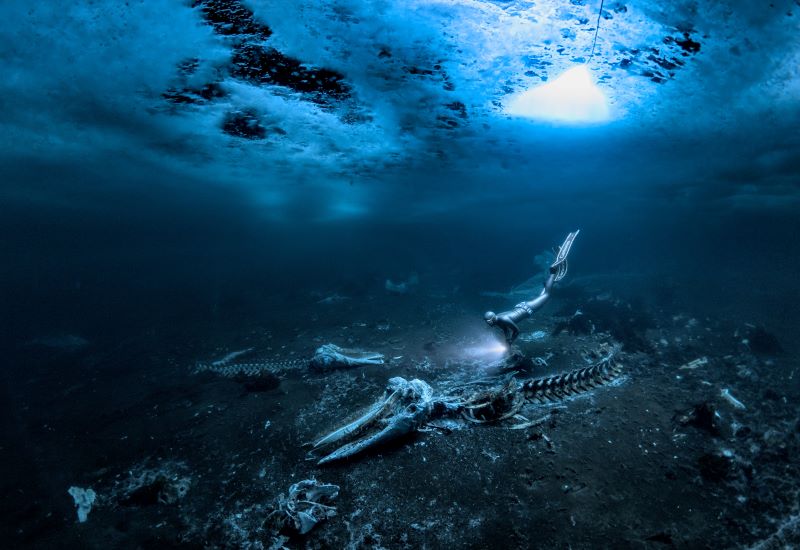
An emotive photograph showing a freediver examining the aftermath of whaling sees
Alex Dawson from Sweden named Underwater Photographer of the Year 2024. Dawson’s
photograph ‘Whale Bones’ triumphed over 6500 underwater pictures entered by underwater
photographers from around the world.
“Whale Bones was photographed in the toughest conditions,” explains chair of judging
panel Alex Mustard, “as a breath-hold diver descends below the Greenland ice sheet to bear
witness to the carcasses. The composition invites us to consider our impact on the great
creatures of this planet. Since the rise of humans, wild animals have declined by 85%. Today,
just 4% of mammals are wildlife, the remaining 96% are humans and our livestock. Our way
needs to change to find a balance with nature.”
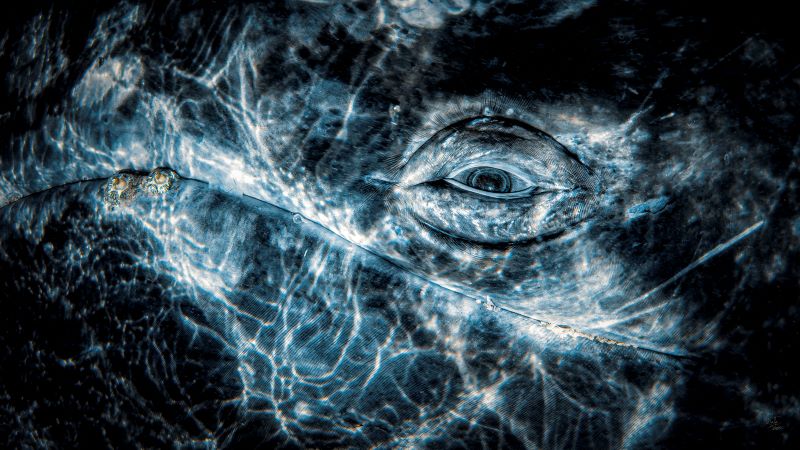
Photo: Rafael
Fernandez Caballero
Whales dominated the winning pictures this year with Spanish photographer Rafael
Fernandez Caballero winning two categories with his revealing photos of these ocean giants:
a close up of a grey whale’s eye and an action shot of a Bryde’s whale engulfing an entire bait
ball, both taken in Magdalena Bay, Baja California, Mexico. Fernandez Caballero took ‘Grey
Whale Connection’ while drifting in a small boat, holding his camera over the side in the water
to photograph the curious whale. ‘The End Of A Baitball’ required Fernandez Caballero to dive
down and be in exactly the right place at the moment the whale lunged. “The photo shows
the high speed attack,” he said, “with the whale engulfing hundreds of kilograms of sardines
in one bite — simply unforgettable to see predation on such a scale.”
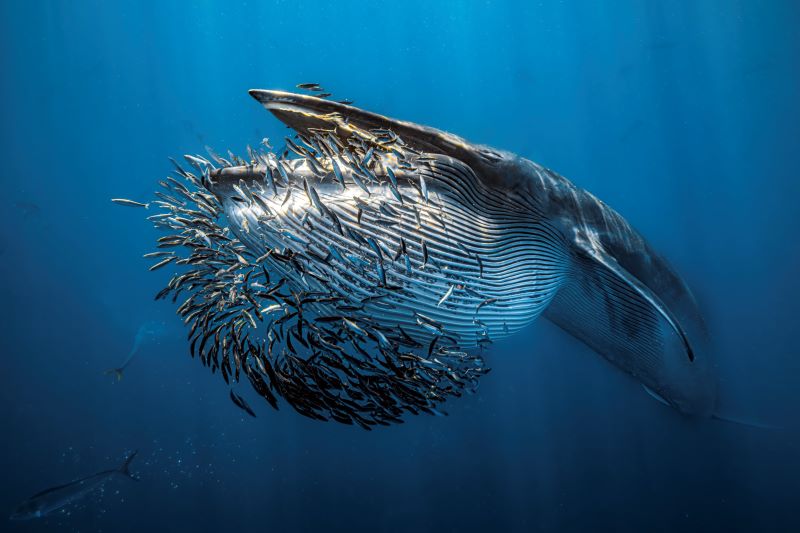
Photo: Rafael
Fernandez Caballero
Lisa Stengel from the United States was named Up & Coming Underwater Photographer of the Year 2024 for her image of a mahi-mahi catching a sardine, in Mexico. Stengel used both a very fast shutter speed and her hearing to catch the moment. “If you listen there’s an enormous amount of sound in the ocean,” she explained. “The action was too fast to see, so I honed in on the sound of the attacks with my camera to capture this special moment.”
“It is such an exciting time in underwater photography because photographers are capturing such amazing new images, by visiting new locations and using the latest cameras,”
commented judge Alex Mustard. “Until this year I’d hardly ever see a photo of a mahi mahi,
now Lisa has photographed one hunting, action that plays out in the blink of an eye.”
The Underwater Photographer of the Year contest is based in the UK, and Jenny Stock,
was named as British Underwater Photographer of the Year 2024 for her image “Star
Attraction”, which finds beauty in species of British wildlife that are often overlooked.
Exploring the west coast of Scotland, Stock explained “in the dark green depths my torch
picked out the vivid colours of a living carpet of thousands of brittle stars, each with a
different pattern. I was happily snapping away, when I spotted this purple sea urchin and I
got really excited.”
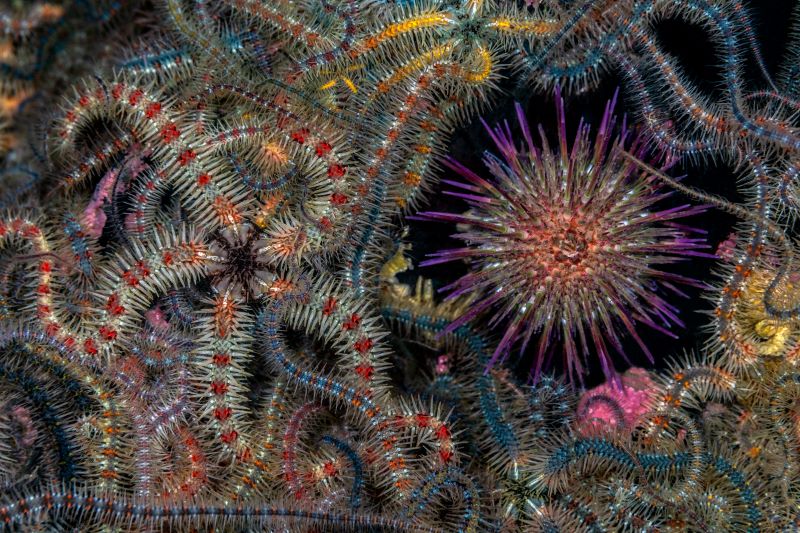
Photo: Jenny Stock
In the same contest, Portuguese photographer, Nuno Sá, was named ‘Save Our Seas
Foundation’ Marine Conservation Photographer of the Year 2024, with his photo ‘Saving
Goliath’, taken in Portugal. Sá’s photo shows beachgoers trying to save a stranded sperm
whale. The picture gives us hope that people do care and want to help the oceans, but also
warns us that bigger changes are needed. “The whale had been struck by a ship and its fate
was sealed,” explains Sá. “An estimated 20,000 whales are killed every year, and many more
injured, after being struck by ships-and few people even realise that it happens.”
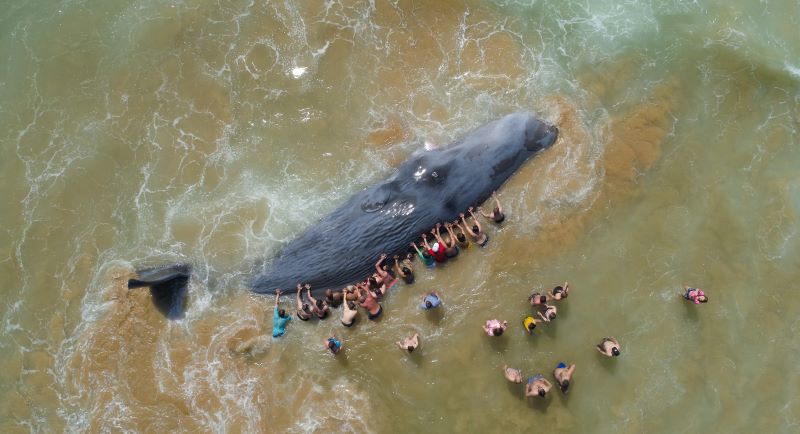
Photo: Nuno Sá
More winning images can be found at www.underwaterphotographeroftheyear.com.
About Underwater Photographer of the Year
Underwater Photographer of the Year is an annual competition, based in the UK, that celebrates photography beneath the surface of the ocean, lakes, rivers and even swimming pools, and attracts entries from all around the world. The contest has 13 categories, testing photographers with themes such as Macro, Wide Angle, Behaviour and Wreck photography, as well as four categories for photos taken specifically in British waters. The winners were announced in an award ceremony in Mayfair, London, hosted by The Crown Estate. This year’s UPY judges were experienced underwater photographers Peter Rowlands, Tobias Friedrich and Dr Alexander Mustard MBE.
Header image: Underwater Photographer of the Year 2024 winner Alex Dawson
News
World’s Best Underwater Photographers Unveil Breathtaking Images at World Shootout 2023
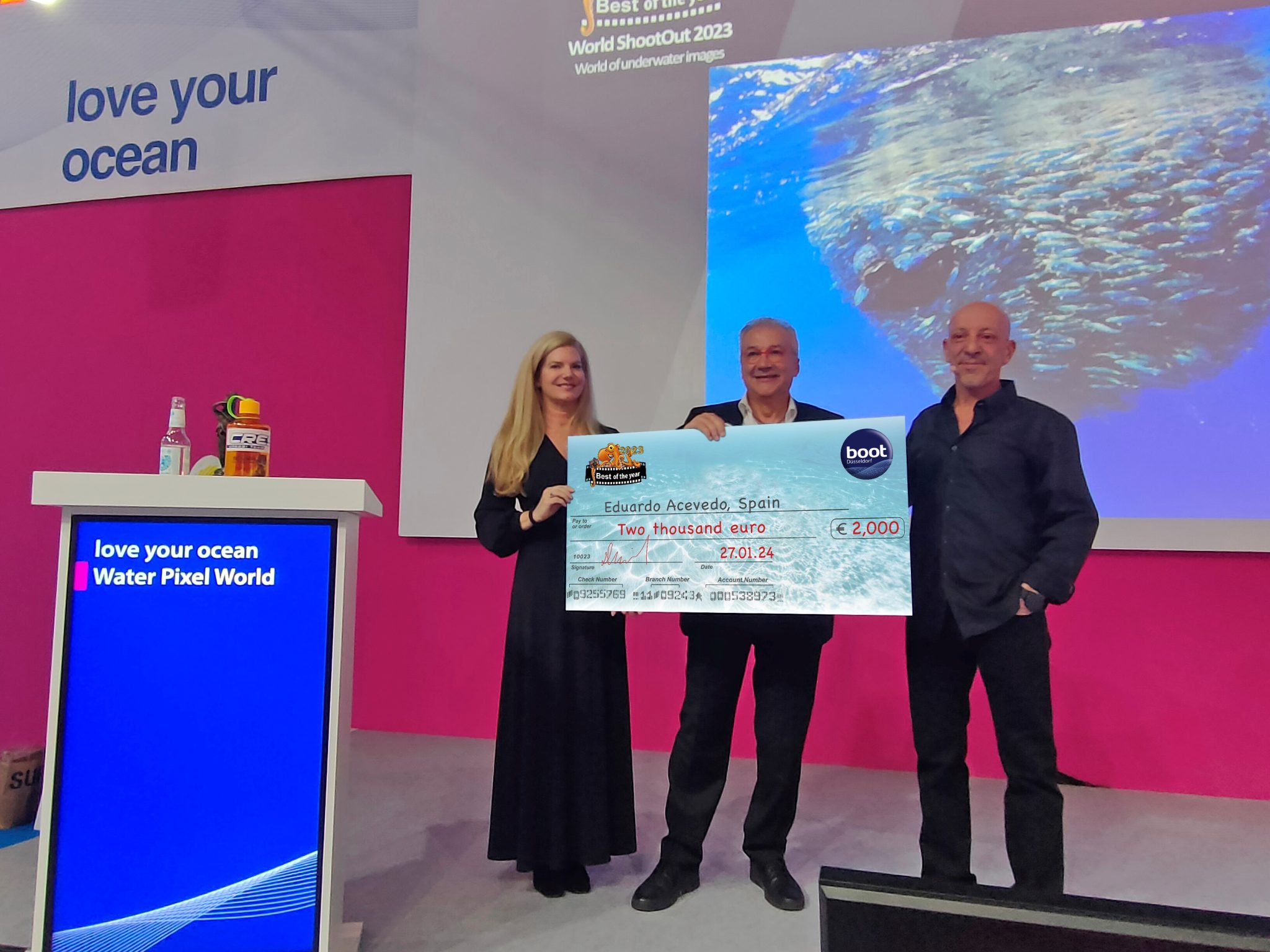
The winners of the prestigious World Shootout 2023 underwater photography competition were announced at this year’s BOOT Show, captivating audiences at the world’s largest diving and water sports exhibition in Dusseldorf, Germany. Hundreds of photographers from 54 countries competed across nine categories, pushing the boundaries of creativity and technical skill.
Grand Prize Winners
- Picture of the Year: Spanish photographer Eduardo Acevedo “secured” the top Honor with the prestigious prize the “boot Dusseldorf Director’s Prize, earning an Andromeda statuette and a €2,000 cash prize.
- Best 5 Images Portfolio: Luc Rooman from Belgium triumphed in this category, winning a dream 4-week diving trip for two to Papua New Guinea, valued at $18,900.
- Amateur Photographer: Alexandra Ceurvorst from the USA impressed the judges with her talent, taking home the 1,000 € cash prize award.
Celebrating Diversity and Innovation
This year’s competition saw 11,680 entries from 964 photographers, showcasing a remarkable spectrum of skills and perspectives. From the intricate wonders of Macro photography to the beauty of “Black Water”, the “Underwater Fashion” category added a touch of artistry and innovation, while the ever-important ” Environmental & Conservation” category served as a powerful reminder of the need to protect these fragile ecosystems.
Looking Ahead: AI and Ocean Conservation
World Shootout founder and producer David Pilosof unveiled an exciting addition for the 2024 competition: this year the Environmental category will be focusing on the impact of plastic on our oceans and future.
This category will embrace the potential of AI or other editing software as a tool to amplify the conservation message.
Entrants will submit campaigns of three original underwater photographs dealing with plastic pollution, along with their final AI assistance processing. This innovative approach encourages artistic expression while raising awareness about a critical environmental issue.
Explore the Stunning Collection
Discover the complete album of competition entries by clicking here.
For Low-resolution photos of finalist entries in eight categories, click here.
-

 News3 months ago
News3 months agoHone your underwater photography skills with Alphamarine Photography at Red Sea Diving Safari in March
-

 News2 months ago
News2 months agoCapturing Critters in Lembeh Underwater Photography Workshop 2024: Event Roundup
-

 Marine Life & Conservation Blogs2 months ago
Marine Life & Conservation Blogs2 months agoCreature Feature: Swell Sharks
-

 Blogs2 months ago
Blogs2 months agoMurex Resorts: Passport to Paradise!
-

 Blogs2 months ago
Blogs2 months agoDiver Discovering Whale Skeletons Beneath Ice Judged World’s Best Underwater Photograph
-

 Gear News3 months ago
Gear News3 months agoBare X-Mission Drysuit: Ideal for Both Technical and Recreational Divers
-

 Gear Reviews2 months ago
Gear Reviews2 months agoGear Review: Oceanic+ Dive Housing for iPhone
-

 Marine Life & Conservation2 months ago
Marine Life & Conservation2 months agoSave the Manatee Club launches brand new webcams at Silver Springs State Park, Florida


